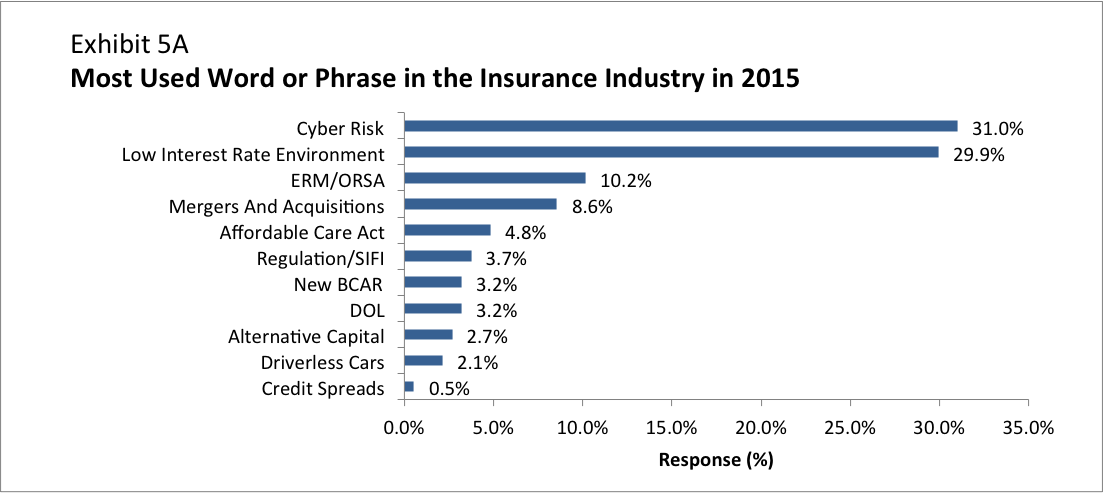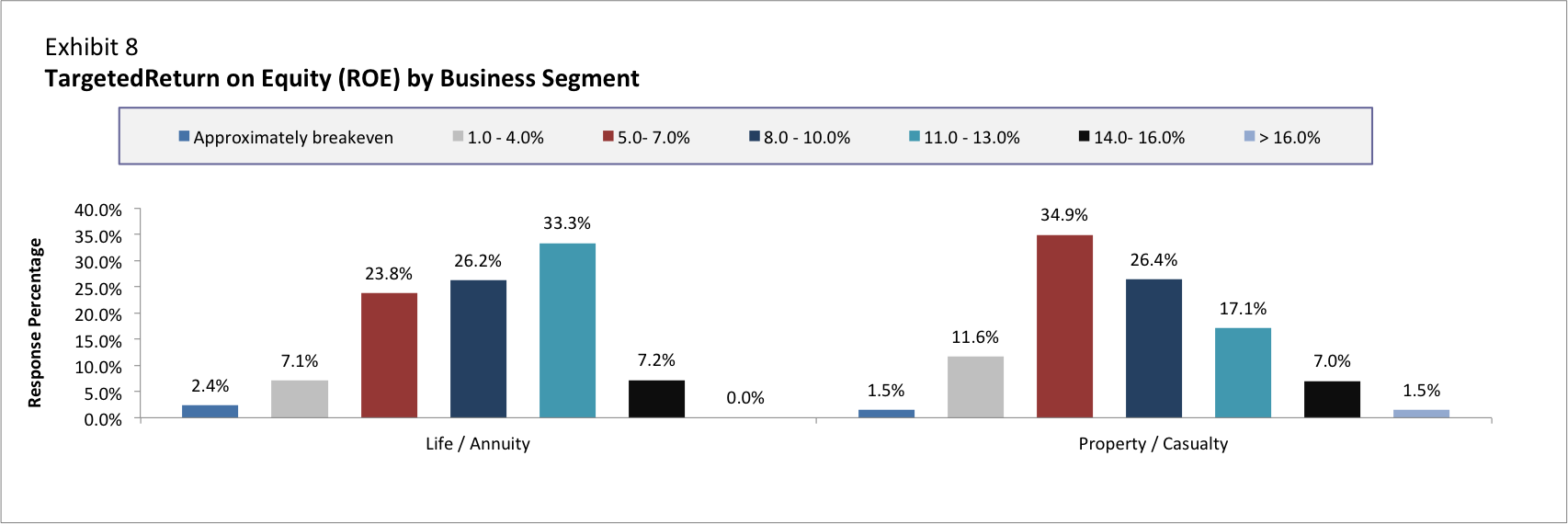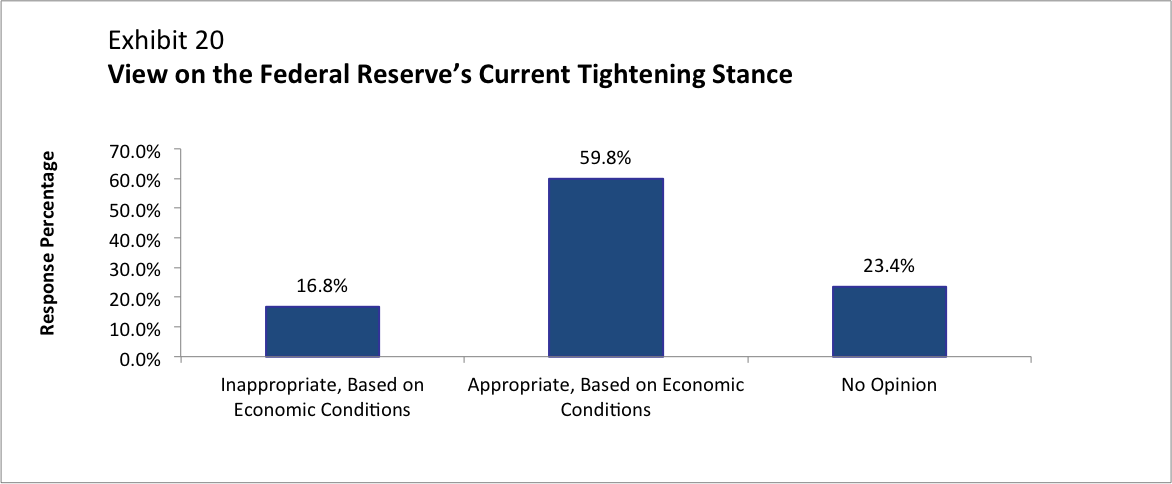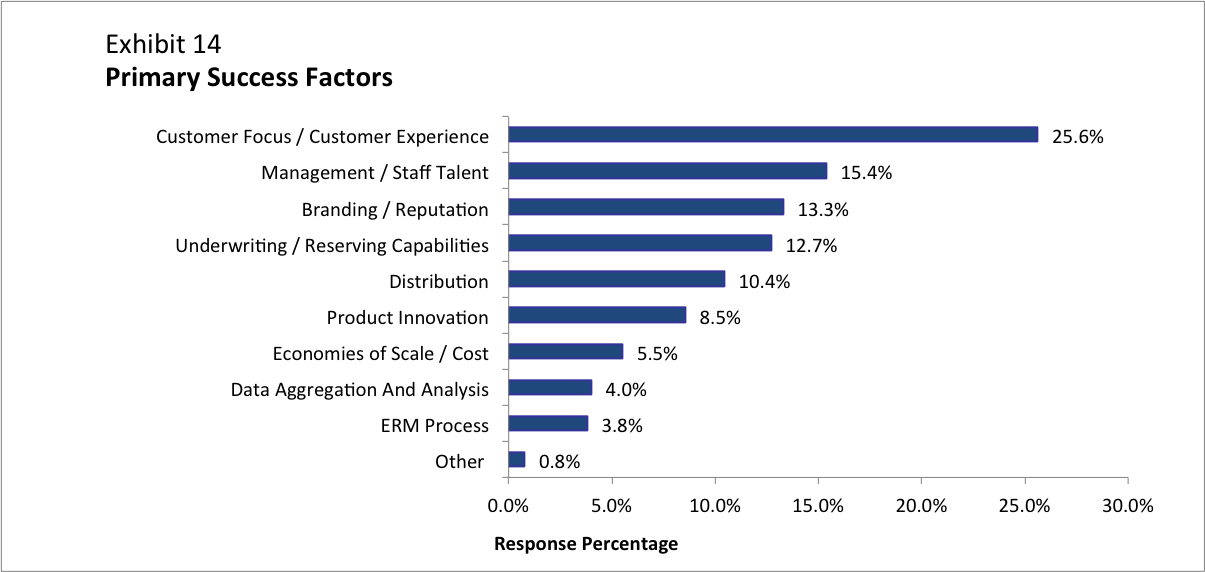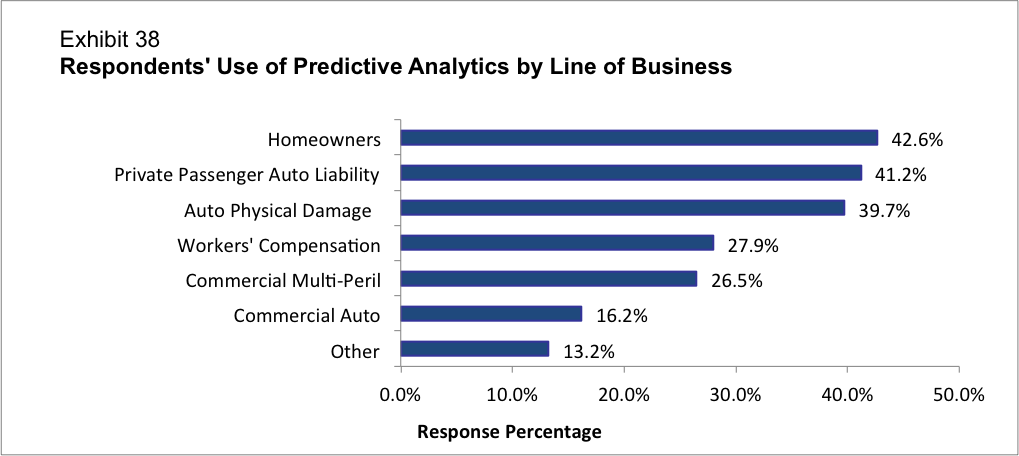Insurers across all sectors — Property & Casualty,Life/Annuity and Health — shared their views on a range of topicsfrom the economy to competition in the industry in A.M. Best'sWinter 2015/2016 Insurance Industry Survey.
|The survey comes as Oldwick, N.J.-based ratingsagency A.M. Best maintains negative outlooks on theCommercial Lines, Reinsurance andHealth segments, and stable outlooks on Personal Lines, Life/Annuity and LifeReinsurance.
|Michelle Baurkot, assistant vice president at A.M. Best, saysthe outlook for Commercial Lines has been negative for some time,and while A.M. Best expects most ratings actions to beaffirmations, rates are under pressure and concerns remainregarding the industry's reserve levels.
|For Reinsurance, despite no large catastrophes in recent years, Baurkot saysthe combined ratio has been creeping up, and challenging conditionsin the marketplace are putting pressure on margins. Healthinsurers, meanwhile, face challenges associated with earningspressure and the Affordable Care Act (ACA).
|The majority of the survey's respondents themselves, though,anticipate conditions across all segments to be stable, except forHealth, where nearly 55% view conditions as negative.
|Asked about the leading disruptors over the next five years, themost common responses were economic events (22.6%), capital markets(14.5%) and political events (13.4%).
|Related: Trump most favorable to insurance industry,according to A.M. Best survey
|A.M. Best says its survey is based on several hundred responsesfrom P&C (70.4%), Life/Annuity (22.2%) and Health insurers(5.3%). The remaining 2.1% identified as Surety, Reinsurance,Credit and Term, or Title Insurance.
|Keep reading to see what insurers are talking about most, whatthey expect for 2016 and how they plan to succeed.
|(Click on graphic to enlarge)
||Thirty-one percent of respondents cited "cyber risk" as themost-used word or phrase for 2016.
|What's the industry talking about?
Cyber risk was top of mind for theinsurance industry in 2015, with 31% of respondents citing it asthe most-used word or phrase for the year. Baurkot says that hasbeen the biggest change since last year. "Cyber risk shot rightup," she says.
|While there has been no major change in the Cyber landscape overthe last year — there are large-scale breaches in the news just asthere have been for the last several years — Baurkot says perhapsbeing exposed to this rapidly evolving risk for one more year hascompanies thinking about the insurance implications.
|For P&C insurers, Baurkot says Cyber is likely top-of-mindas they look into developing products to sell. And P&C insurerswere most likely to mention Cyber as the top buzzword of 2015(34.6%). But many Life/Annuity (28.6%) and Health insurers (10%)also cited Cyber as the most-discussed word. Baurkot says thesurvey did not get into what in particular each company discussedwith respect to the most-used buzzwords, but she says forLife/Annuity and Health insurers, discussions around Cyber probablyinvolved protecting their own information and data as breaches become more common andextensive.
|The low interest rate environment placed second behind Cyber asthe most-used phrase in the insurance industry, at 29.9%, down onlyslightly from last year, according to Baurkot. It ranked first(40%) for Life/Annuity and Health insurers (30% — tied with theACA), and second (25.4%) for P&C insurers.
|Baurkot says other topics of discussion that ranked high lastyear, such as Enterprise Risk Management/Owned Risk and SolvencyAssessment and the ACA, were not as prominent this year, although,the ACA was top-of-mind for health insurers (30%) even if it wasfar lower down on the list for the insurance industry overall(4.8%).
|Regarding the ACA, Baurkot says much of the discussion last yearwas likely over the uncertainty. "This year," she says, "it lookslike it's playing out — maybe not ideally — but I think people cansee what the expectation is, so that may have been why it droppedoff a little bit from last year."
|Continue reading …
|(Click on graphic to enlarge)
||Forty-eight percent of P&C carriers expect returns onequity of 7% or less.
|Targeted returns for 2016
Forty-six percent of insurers expect returns on equity between8% and 13%, while just 9.2% expect returns over 14%. Life/Annuityinsurers were more optimistic than P&C carriers. For P&C,48% expect returns of 7% or less, compared to 33.3% of Life/Annuitycompanies. Meanwhile, 40.5% of Life/Annuity companies expectreturns on equity of 11% or more compared to 25.5% of P&Ccompanies.
|Baurkot says expectations have fallen "quite a bit" in recentyears, with a significant downward trend since 2014. This year, shesays there was a lot more focus on what the Fed would, or wouldnot, do on interest rates, "and that could havean impact on thoughts on interest rates and likewise targetedreturns on equity."
|(Click on graphic to enlarge)
|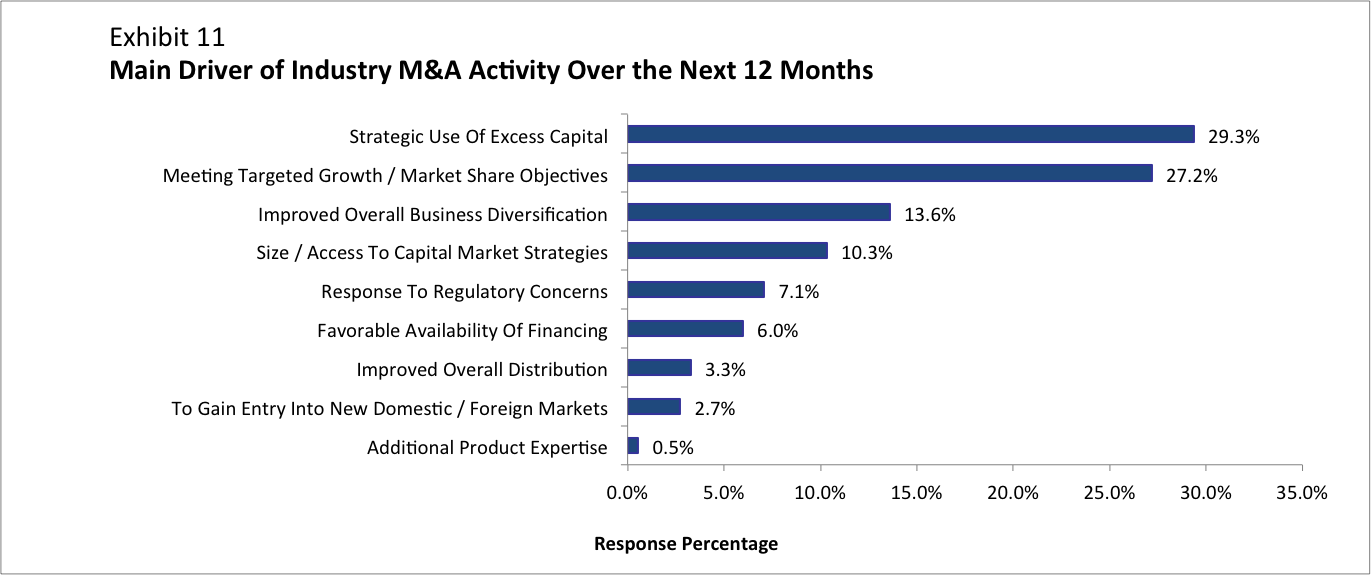 Mergers and acquisitions activity hit record highsin 2015, and is expected to continue to be strong thisyear.
Mergers and acquisitions activity hit record highsin 2015, and is expected to continue to be strong thisyear.
Mergers and acquisitions
While mergers and acquisitions (M&A) interest is higher forlarger insurance companies, A.M. Best notes that companies of all sizes are expressing someinterest. According to the survey, 66.3% ofrespondents are considering M&A for various strategic reasonstied to expansion of the business, while 32.6% say they do not planto participate in any type of M&A this year.
|A.M. Best says, "While very few cite regulatory pressures as adriver of M&A interest, we note MetLife's recently announcedsale of its domestic retail advisor force to MassMutual, coming onthe heels of MetLife's challenge of its designation as a non-banksystemically important financial institution by the FinancialStability Oversight Council."
|Asked about the main drivers of industry M&A activity in2016, 29.3% of insurers cite strategic use of excess capital, andthis is certainly the case for P&C insurers, where alternativecapital has been flooding into the marketplace.
|For primary P&C insurers, Baurkot says they now have muchmore flexibility when buying reinsurance, "which is making it anexpense savings to some extent. If they have savings from shoppingaround for reinsurance, do they have more capital to useelsewhere?" she asks, noting that looking into a merger oracquisition could be one area to deploy that capital.
|For health insurers, Baurkot says the past year wasactive for M&A, but it was morerelated to trying to increase scale and diversify products.Meanwhile, Life/Annuity companies, Baurkot says, have been heavilyimpacted by interest rates, and because interest rates haveremained so low for so long, companies have had to decide if theycan continue to manage through that environment, or if they shouldlook at combining with other companies.
|Continue reading …
|(Click on graphic to enlarge)
||Overwhelmingly, respondents felt that competition in theinsurance marketplace is growing more intense.
|Competition and the economy
Competition from regulatory changes and from new marketentrants decreased in this survey compared to Fall 2015 (from 8.1%to 5.9% and from 11.7% to 9.1% respectively). Meanwhile,competition from existing players jumped from 36% in the fall to44.1% in the current survey.
|For P&C insurers, Baurkot says access to capital may well beplaying a role in the increase in competition from existingplayers, in addition to the current pricing cycle. Rates are low inmost lines, fueling competition, she says.
|Competition because of macro economic factors also increasedfrom the fall, from 14.3% to 18.3%, and insurers reporting stableconditions dropped from 28.9% to 21%.
|On the economy, just 5.4% of insurers say economic conditionswill improve this year, while 30.4% expect conditions todeteriorate. Another 46% expect conditions to remain stable. About80% say GDP growth will be 2% or lower, with 50% saying GDP wouldgrow at 1.5% or less. Just 2.8% say GDP increases would exceed2.5%.
|(Click on graphic to enlarge)
||Asked about the Federal Reserve's current policy based oneconomic conditions, almost 60% of respondents indicated that thepolicies were appropriate while 16.8% felt they were not. Mostinsurers felt that the Fed would tighten interest rates one or twomore times this year, with slightly more expecting two hikes thanone.
|Continue reading …
|(Click on graphic to enlarge)
||Across the insurance industry, delivering a good customerexperience is seen as increasingly paramount tosuccess.
|Success factors
Insurers overwhelmingly attribute their success to focusing oncustomers (25.6%). A.M. Best notes, "As is widely reported,insurers are focusing on their customers through technology. Many recognize thatcustomers increasingly turn to online and mobile platforms to shopfor insurance products and carriers are developing seamless,easy-to-use interfaces for those individuals."
|Baurkot says success is all about getting to the customer "nomatter where they are and how they want access" — be it throughapps on a phone or on a computer. Insurers are working on buildingout their platforms, apps and tech abilities to meet this demand,she adds.
|Other factors insurers cite for their success: talent ofmanagement and their staff (15.4%), branding/reputation (13.3%),and underwriting/reserving capabilities (12.7%).
|A.M. Best says, "Of note, economies of scale, data aggregationand analysis, as well as a robust ERM process did not appear to besignificant.
|Continue reading …
|(Click on graphic to enlarge)
||Predictive analytics
Less than half (48.9%) of insurers say they use predictiveanalytics. For those that do, underwriting was by far the mostsignificant area of focus (82.2%), followed by claims (39.7%).
|By line of business, predictive analytics is used mostfrequently in Homeowners (42.6%) followed by Private Passenger AutoLiability (41.2%) and Physical Damage (39.7%). There is anoticeable drop off to use in Commercial Lines coverages, withWorkers' Comp leading the way (27.9%).
|Related: 4 trends that will shape the U.S. Property &Casualty market in 2016
|Have you Liked us on Facebook?
Want to continue reading?
Become a Free PropertyCasualty360 Digital Reader
Your access to unlimited PropertyCasualty360 content isn’t changing.
Once you are an ALM digital member, you’ll receive:
- All PropertyCasualty360.com news coverage, best practices, and in-depth analysis.
- Educational webcasts, resources from industry leaders, and informative newsletters.
- Other award-winning websites including BenefitsPRO.com and ThinkAdvisor.com.
Already have an account? Sign In
© 2024 ALM Global, LLC, All Rights Reserved. Request academic re-use from www.copyright.com. All other uses, submit a request to [email protected]. For more information visit Asset & Logo Licensing.


